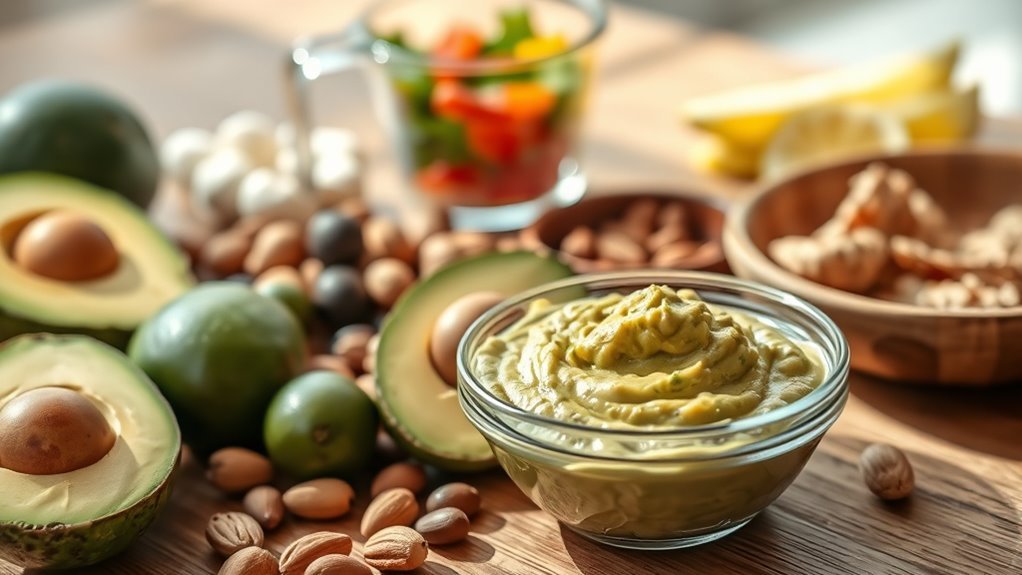To maintain ketosis, you should limit your daily carb intake to between 20 to 50 grams. This restriction helps shift your body’s primary energy source from glucose to fat, promoting weight loss and improved energy levels. Individual needs may vary based on your metabolism and activity level, so monitoring your intake is vital. By tracking what you eat and understanding carb sources, you’ll set yourself up for success in your keto journey and discover even more important tips.
Understanding Ketosis and Its Importance

When you reduce your carb intake considerably, your body enters a state called ketosis, which is essential for those following a ketogenic diet. In ketosis, your body shifts from using glucose as its primary energy source to burning fat for fuel. This metabolic adaptation can lead to various ketosis benefits, such as improved energy levels, enhanced mental clarity, and weight loss. By tapping into stored fat, you can experience greater freedom from hunger and cravings. Additionally, ketosis may help stabilize blood sugar levels, making it easier to maintain healthy energy throughout the day. Understanding these mechanisms empowers you to make informed dietary choices that align with your goals, ultimately fostering a lifestyle that prioritizes health and autonomy.
Recommended Daily Carb Intake for Keto

To successfully enter and maintain ketosis, it’s vital to adhere to a specific daily carbohydrate intake. Generally, keto carb limits suggest keeping your net carbs between 20 to 50 grams per day. This range aligns with daily carb guidelines that help your body shift from burning glucose to burning fat as its primary energy source. Staying within these limits can enhance fat oxidation, leading to effective weight loss and increased energy levels. Remember, everyone’s needs may differ slightly, so monitoring how your body responds is important. Ultimately, maintaining a low carb intake empowers you to enjoy the benefits of the keto lifestyle while embracing the freedom of choosing what works best for you.
Factors Influencing Carb Needs

Your carb needs on a keto diet can vary considerably based on your individual metabolic rate and activity level. Higher metabolism often allows for a few more carbs, while a more active lifestyle may require adjustments to maintain ketosis. Understanding these factors is essential for tailoring your carb intake effectively.
Individual Metabolic Rate
Understanding your individual metabolic rate is vital for determining the right carbohydrate intake on a keto diet, as it varies greatly from person to person. Your metabolic rate influences how efficiently your body processes carbs and fats, impacting your overall energy levels. Individual variations, such as genetics, age, and hormonal balance, play a significant role in this process. Additionally, metabolic flexibility—the ability to switch between burning carbs and fats—is essential for adapting to a low-carb lifestyle. By evaluating your unique metabolic needs, you can tailor your carb intake to promote fat burning while maintaining energy and mental clarity. Embracing your distinct metabolic profile allows you to optimize your keto journey and enjoy greater freedom in your food choices.
Activity Level
Activity level plays an essential role in determining how many carbs you might need on a keto diet. If you engage in high-intensity workouts, your body may require more carbohydrates to fuel those efforts, especially during longer workout durations. Conversely, if your activity is less intense or shorter, you might be able to stick to lower carb limits. It’s vital to listen to your body; increased activity intensity can lead to greater glycogen depletion, necessitating additional carbs to recover effectively. Adjusting your carb intake based on your workout routine allows you the freedom to enjoy your keto journey while maintaining energy levels. Ultimately, finding the right balance will help you stay energized and committed to your fitness goals.
Tracking Your Carb Intake
Tracking your carb intake is essential for staying within your ketogenic goals and achieving ideal results. With various tools available, like apps and food diaries, monitoring your consumption can be straightforward and effective. Regular adjustments to your carb goals based on your progress will help you maintain the right balance for your body.
Importance of Carb Tracking
While you might think that following a keto diet is solely about cutting carbs, accurately tracking your carb intake is essential for achieving and maintaining ketosis. Carb counting helps you understand how many carbs you’re consuming daily, enabling you to make necessary dietary adjustments. Without tracking, it’s easy to overindulge in hidden carbs, which can disrupt ketosis and hinder your progress. Monitoring your intake allows you to identify patterns in your eating habits, making it easier to stay within your desired carb limit. This awareness empowers you to make informed choices, ensuring your keto journey aligns with your goals. Ultimately, precise tracking gives you the freedom to enjoy your meals while staying committed to the ketogenic lifestyle.
Tools for Monitoring Intake
To successfully manage your carb intake on a keto diet, utilizing the right tools can make all the difference. Carb tracking apps are essential for keeping an accurate record of what you’re eating. These apps allow you to log meals, scan barcodes, and calculate your daily carb intake effortlessly. Popular options include MyFitnessPal, Carb Manager, and Cronometer, which offer user-friendly interfaces and customizable features. Additionally, intake monitoring tools, like food journals or spreadsheets, can provide a more personalized approach, helping you spot trends and adjust as necessary. By leveraging these resources, you gain the freedom to enjoy your keto journey while staying on track with your carb goals. Your success hinges on how well you monitor your intake!
Adjusting Carb Goals
Adjusting your carb goals is essential for staying aligned with the ketogenic diet’s principles, especially as your body adapts to a low-carb lifestyle. Tracking your carb intake helps you determine your target carbs, which can vary based on your activity level and metabolic state. If you’re looking to enhance fat loss or muscle gain, consider carb cycling—alternating between low and higher carb days. This approach can help you maintain flexibility while still reaping the benefits of ketosis. Regularly evaluate how your body responds, and don’t hesitate to tweak your goals as needed. Remember, the key to success is finding a balance that keeps you feeling free and energized while adhering to your keto lifestyle.
Types of Carbohydrates to Avoid
When starting on a ketogenic diet, it’s crucial to identify and avoid certain types of carbohydrates that can hinder your progress. These carbs can spike your blood sugar and kick you out of ketosis. Focus on steering clear of:
Avoiding specific carbohydrates is essential for success on a ketogenic diet, as they can disrupt ketosis and affect blood sugar levels.
- Simple sugars like candy and desserts
- Refined grains found in white bread and pasta
- Starchy vegetables such as potatoes and corn
- Processed snacks high in carbs, like chips and crackers
- High carb fruits, including bananas and grapes
Foods to Include on a Keto Diet
While managing a ketogenic diet, it’s essential to incorporate foods that are low in carbohydrates but high in healthy fats and proteins. Focus on keto friendly vegetables like leafy greens, broccoli, and cauliflower, which provide essential nutrients without spiking your carb intake. Include avocados, nuts, and seeds for their healthy fats, promoting satiety and energy. Incorporating fatty cuts of meat, eggs, and full-fat dairy can also support your nutritional goals while keeping carbs minimal. Don’t forget about low-carb condiments and herbs to enhance flavor without adding excess sugars. By selecting these foods, you’ll create a satisfying and diverse menu that aligns with your keto lifestyle, giving you the freedom to enjoy your meals without the guilt.
Signs You’re in Ketosis
How can you tell if you’re in ketosis? Recognizing ketosis symptoms can help you confirm you’ve entered this metabolic state. Here are some signs to look for:
Recognizing ketosis symptoms can confirm your entry into this metabolic state and guide your keto journey.
- Increased energy: You might feel a boost in stamina and mental clarity.
- Fatigue: Initially, you may experience some tiredness as your body adjusts.
- Bad breath: A fruity or metallic smell can result from ketones in your breath.
- Weight loss: Noticeable changes in body weight can indicate fat burning.
- Reduced appetite: You may find you’re less hungry throughout the day.
Pay attention to these signs, as they can guide you on your keto journey and help you embrace the freedom that comes with a low-carb lifestyle.
Adjusting Carb Intake for Your Goals
Recognizing the signs of ketosis is just the beginning of your keto journey; adjusting your carb intake is vital for optimizing your results. Tailoring your carb levels to match your goals—whether it’s weight loss, muscle gain, or improved athletic performance—can greatly enhance your experience. Carb cycling, where you alternate between low and higher carb days, can be an effective strategy for those looking to maximize fat loss while maintaining energy levels. Goal setting is essential; define what you want to achieve and modify your carb intake accordingly. By fine-tuning your approach, you gain the freedom to enjoy your meals while still progressing towards your desired outcomes. Stay mindful, track your results, and adjust as needed for lasting success on your keto journey.


